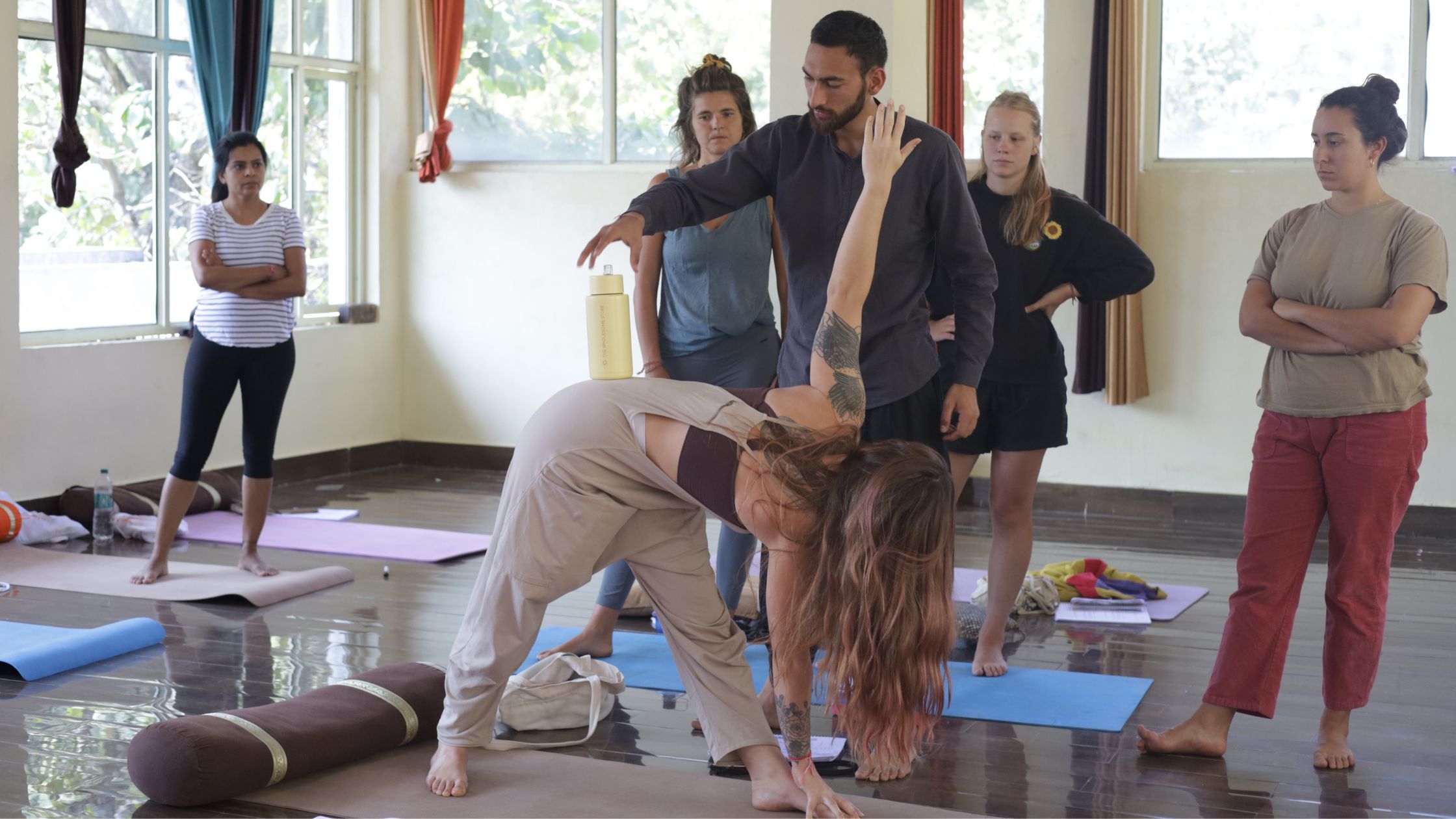

Becoming an international yoga teacher in India requires a combination of dedication, hard work, and a deep understanding of yoga. It is essential to develop a strong practice and gain experience teaching before seeking international opportunities. This blog will help you understand some of the key learnings and practises that you should adopt before you start teaching.
- Develop a Strong Practice: Before you can teach yoga, you need to develop a strong personal practice. Practice yoga regularly and consistently and deepen your practise by focusing on a deeper understanding of the postures: its anatomy and alignment, its philosophy and breath work, and the meditation that will suit a particular asana sequencing. Example a back bending vinyasa sequence can end with a meditation practise focusing on heart and throat chakra. Your practise will help you learn to design the best class and be innovative, as it will come from your experience. Attend workshops and classes with experienced teachers to gain further insight and deepen your understanding of yoga.
- Gain Experience of Teaching: Teaching yoga is an art that requires practice, patience, and compassion. Starting to teach can be intimidating, especially if you’re new to yoga teaching. However, by creating a supportive environment and starting small, you can gradually build your confidence and develop your teaching skills. Begin by teaching friends, family, and colleagues to gain experience in a supportive environment. Take a Yoga teacher training course to learn the skills and techniques needed to teach yoga safely and effectively. Volunteer at local studios and community centers to gain further experience and build your teaching skills.
- Work on your emotions as a teacher: Teaching yoga requires a calm and centered mind, and there are certain emotions that can hinder your ability to teach effectively. Here are some emotions that may not be helpful when teaching:
Ø Anger: Teaching yoga with anger can create a tense and negative environment, making it difficult for students to relax and connect with their practice. Anger can also cloud your judgment and lead to impulsive decisions that may not be in the best interest of your students.
Ø Frustration: Frustration can arise when students are not following instructions or are not progressing as quickly as you would like. However, expressing your frustration can create a negative and judgmental atmosphere, making it difficult for students to feel safe and supported in their practice.
Ø Insecurity: Insecurity about your teaching abilities can lead to self-doubt and uncertainty, making it difficult to communicate effectively with your students. Insecurity can also cause you to be overly critical of yourself, leading to a negative self-image and a lack of confidence in your abilities.
Ø Impatience: Impatience can create a rushed and chaotic environment, making it difficult for students to fully engage with their practice. Impatience can also lead to an overemphasis on achieving physical postures, rather than focusing on the breath and inner experience.
Ø Judgment: Judging your students or yourself can create a negative and critical environment, making it difficult for students to feel supported and safe in their practice. Judgment can also lead to an overemphasis on physical appearance, rather than the inner experience of the practice.
It’s important to work on these emotions by doing some breathing and meditation practise before you start teaching, so you can impart the same knowledge to the students.
- Empowered Yoga teaching: Empowered yoga teaching is about creating an environment in which students feel safe, supported, and encouraged to explore their practice. It is about giving students the tools they need to make their own choices and decisions about their practice, and providing them with a sense of autonomy and empowerment. Empowered yoga teaching involves creating a collaborative relationship with your students, in which you listen to their needs and preferences, and work together to create a practice that is tailored to their unique needs and goals. This may involve offering modifications or variations to poses, or allowing students to make their own choices about how they move and breathe. Create a sense of community and connection within your classes which can be achieved by encouraging students to support and uplift each other, and by creating a non-judgmental environment where everyone is accepted and valued. By providing a supportive and collaborative environment, and by empowering students to make their own choices and decisions, you can help your students to connect with their practice on a deeper level, and to experience the transformative power of yoga in their lives.
- Get Certified: There are several yoga teacher training programs available in India that provide certification recognized internationally. Yoga Alliance is the most widely recognized accreditation organization for yoga teacher training. Yoga Alliance recognizes schools that provide a curriculum meeting its standards, and upon completion of the training, you will receive a certificate that is recognized internationally. Ensure you check the credibility of the school before enrolling in a program. Vinyasa Yoga Ashram is one of the best Registered Yoga Schools in Rishikesh, India. They offer courses like 200 hour Yoga TTC, 300 hour Yoga TTC, Pre and postnatal Yoga TTC and Aerial Yoga TTC that will help the Yoga teachers to polish their teaching skills and get internationally accredited certification
- Specialize in a Style: Yoga is a vast practice, and there are many different styles to choose from. To become an international yoga teacher in India, you should specialize in a particular style that aligns with your personal practice and resonates with you. Specializing in a particular style will help you stand out as a teacher, and you will have a deeper understanding of the postures, philosophy, and history of that style.
- Build a Network: Networking is critical in any industry, and the yoga community is no exception. Attend workshops, conferences, and events to meet other teachers and build relationships with them. Connect with teachers in India, join online communities, and collaborate with other teachers to gain exposure to different teaching styles and opportunities.
- Gain International Teaching Experience: Once you have gained experience teaching in India, it’s time to gain international teaching experience. Attend workshops and retreats abroad, or offer to teach at studios in other countries. Building a network of international students and colleagues will give you a global perspective on yoga and provide opportunities for growth and development.
- Marketing yourself: Marketing yourself as a yoga teacher is crucial to building a successful career. Create a website or a social media profile where you can showcase your teaching style, philosophy, and experience. Ensure you have a professional headshot, and that your website or profile is well-designed and easy to navigate. Utilize word-of-mouth, social media, and other marketing strategies to promote yourself as an international yoga teacher.
Becoming an international yoga teacher in India takes dedication, hard work, and a deep understanding of yoga. However, by following the steps outlined above and continuing to develop your practice and teaching skills, you can achieve your goal of becoming an international yoga teacher.
Contact us for our upcoming teacher training courses that will help you in your teaching career.

